Lychgate
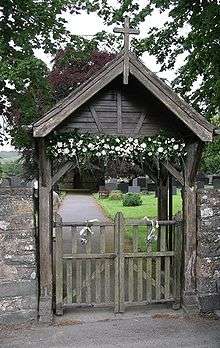
A lychgate, also spelled lichgate, lycugate, lyke-gate or as two separate words lych gate, (from Old English lic, corpse) is a gateway covered with a roof found at the entrance to a traditional English or English-style churchyard. Examples exist also outside the British Isles in places such as Sweden.
Name
The word lych survived into modern English from the Old English or Saxon word for corpse, mostly as an adjective in particular phrases or names, such as lych bell, the hand-bell rung before a corpse; lych way, the path along which a corpse was carried to burial (this in some districts was supposed to establish a right-of-way); lych owl, the screech owl, because its cry was a portent of death; and lyke-wake, a night watch over a corpse (see Lyke-Wake Dirge).
Compare modern German "Leiche", Dutch "lijk", Frisian "lyk", and Swedish "lik", all meaning corpse.
Use
In the Middle Ages, before mortuaries, and at a time when most people died at home, the dead were placed on a bier and taken to the lychgate where they remained, often attended against bodysnatchers, until the funeral service, which may have been a day or two later. The lychgate kept the rain off, and often have seats for the vigil watchers. Bodies at that time were buried in just shrouds rather than coffins. At the funeral, the priest conducted the first part of the service under the shelter of the lychgate.
Description

Lychgates consist of a roofed porch-like structure over a gate, often built of wood. They usually consist of four or six upright wooden posts in a rectangular shape. On top of this are a number of beams to hold a pitched roof covered in thatch or wooden or clay tiles. They can have decorative carvings and in later times were erected as memorials. They sometimes have recessed seats on either side of the gate itself, for the use of pall-bearers or vigil watchers.
The body rested inside the Churchyard, so the gates themselves should be under the edge of the roof, between the end columns, rather than in the centre as is usually the case with modern lychgates.
The gateway was really part of the church. It was where the clergy met the corpse and the bier rested while part of the service was read before burial. It also served to shelter the pall-bearers while the bier was brought from the church. In some lych gates there stood large flat stones called lich-stones upon which the corpse, usually uncoffined, was laid. The most common form of lych gate is a simple shed composed of a roof with two gabled ends, covered with tiles or thatch. At Berrynarbor, Devon, there is a lychgate in the form of a cross, while at Troutbeck, Westmorland, there are three lychgates to one churchyard. Some elaborate gates have chambers over them.
Most were built from around the mid 15th century although some date from earlier, including the 13th century lychgate of St George's churchyard in Beckenham, South London, claimed to be the oldest in England.[1] Several new examples were built to mark the new Millennium, such as those at Lenton, Lincolnshire, and Careby.
Use at weddings
Traditionally in some parts of England, particularly parts of Yorkshire, at the end of the wedding as the bride and groom leave the church the gates are closed (or where there is an absence of gates a rope is held across) by the local children and the couple have to pay them to let them pass.
Examples
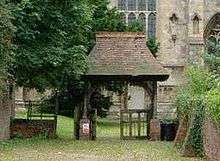 A traditional English lychgate.
A traditional English lychgate.- Millennium lychgate at Lenton, Lincolnshire.
- A rare Scottish example at Cummertrees.
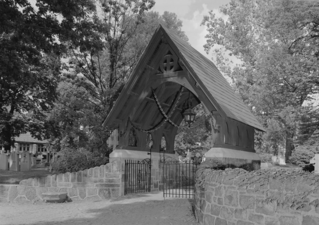 Lychgate at the Church of St. James the Less, Philadelphia.
Lychgate at the Church of St. James the Less, Philadelphia.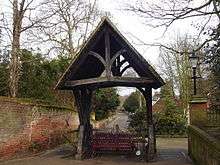 Lychgate at St. Michael's church, Aylsham.
Lychgate at St. Michael's church, Aylsham.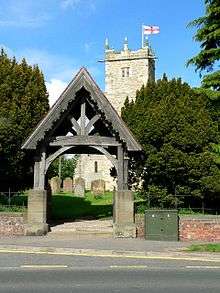 Lychgate of All Saints Parish Church, Shiptonthorpe.
Lychgate of All Saints Parish Church, Shiptonthorpe. Lychgate at St.Mary's parish church, Castle Eaton.
Lychgate at St.Mary's parish church, Castle Eaton.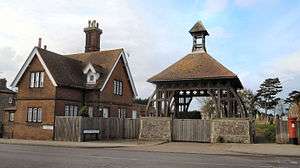 Lychgate at Kirkley Cemetery, Lowestoft
Lychgate at Kirkley Cemetery, Lowestoft Lychgate designed by John Douglas at St Michael's Church, Manafon.
Lychgate designed by John Douglas at St Michael's Church, Manafon. Early 20th-century lychgate at St Andrew's Church, West Tarring.
Early 20th-century lychgate at St Andrew's Church, West Tarring.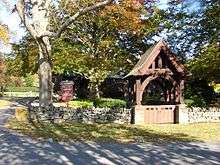 Lychgate at St. Columba's Chapel (Middletown, Rhode Island).
Lychgate at St. Columba's Chapel (Middletown, Rhode Island).- Lychgate at St Wulfran's Church, Ovingdean.
 Lychgate at St. Anne's Chapel (Fredericton)
Lychgate at St. Anne's Chapel (Fredericton)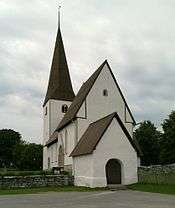 Lychgate at Alskog Church, Gotland (Sweden)
Lychgate at Alskog Church, Gotland (Sweden) Lychgate at Garde Church, Gotland
Lychgate at Garde Church, Gotland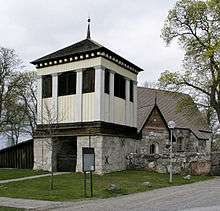 Combined lychgate and bell tower at Rö Church, Sweden
Combined lychgate and bell tower at Rö Church, Sweden
See also
![]() Media related to Lychgates at Wikimedia Commons
Media related to Lychgates at Wikimedia Commons
References
![]() This article incorporates text from a publication now in the public domain: Chisholm, Hugh, ed. (1911). "article name needed". Encyclopædia Britannica (11th ed.). Cambridge University Press.
This article incorporates text from a publication now in the public domain: Chisholm, Hugh, ed. (1911). "article name needed". Encyclopædia Britannica (11th ed.). Cambridge University Press.
- 1 2 Brewer's Britain and Ireland, compiled by John Ayto and Ian Crofton, Weidenfeld & Nicolson, 2005, ISBN 0-304-35385-X
External links
| Look up lych-gate in Wiktionary, the free dictionary. |
| Wikisource has the text of the 1905 New International Encyclopedia article Lich-gate. |
- A restoration of a lych gate at Houghton-le-Spring's Hillside Cemetery
- Horsham's Denne Road Lych Gate featuring a traditional lychgate
- Otterbourne lychgate
- Illustrated article on lych gates in Newfoundland, Canada